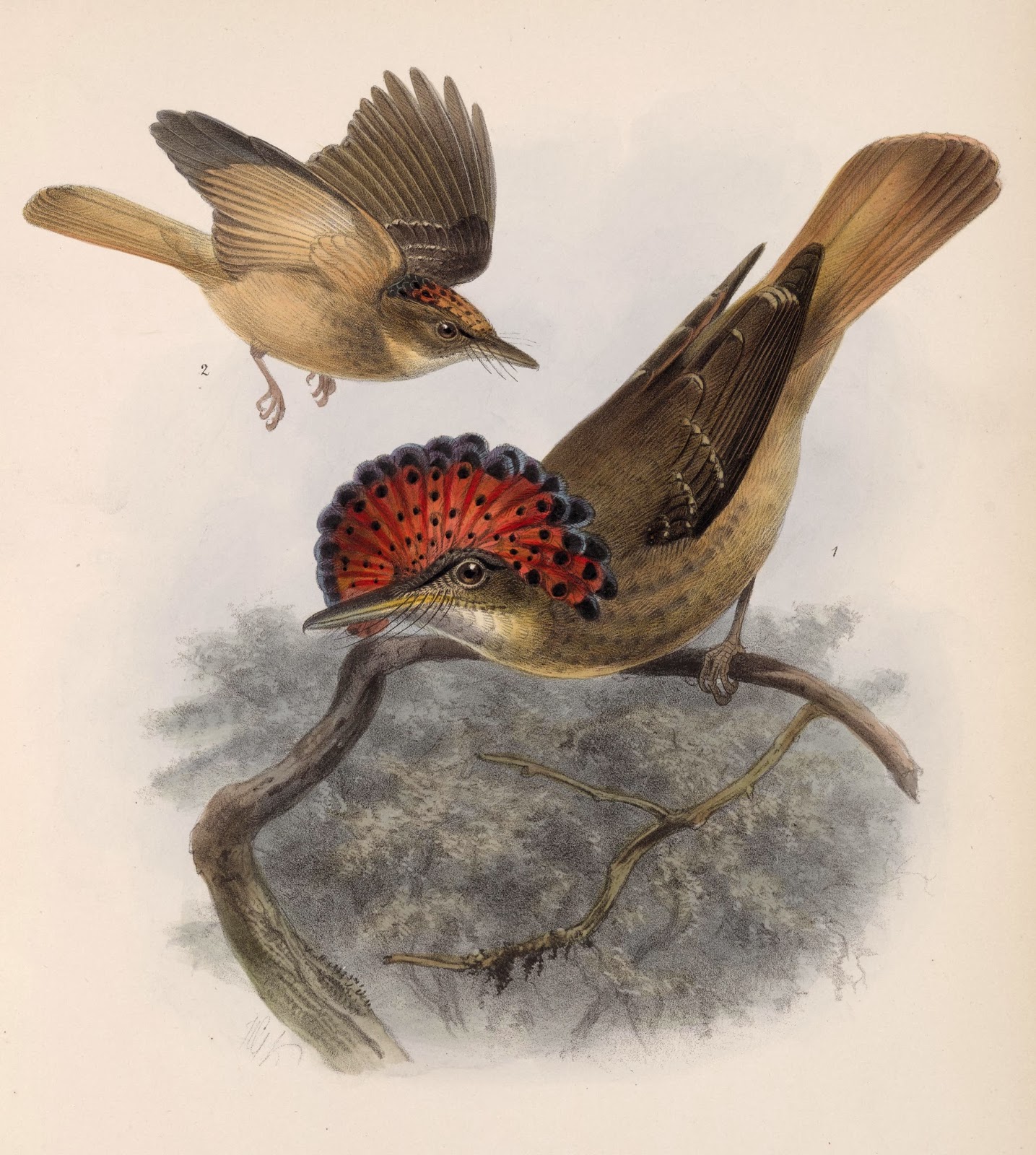From Wikipedia, the free encyclopedia.
The Royal Flycatchers are birds in the genus Onychorhynchus in the Tityridae family. Depending on authority, it includes a single widespread, or four more localized species. The specific epithet of the type species, coronatus, and the common name of all the species in this genus, Royal Flycatcher, refer to the striking, colourful crest, which is seen displayed very rarely, except after mating, while preening, in courtship as well as being handled.
Distribution and population
The Royal Flycatchers are birds in the genus Onychorhynchus in the Tityridae family. Depending on authority, it includes a single widespread, or four more localized species. The specific epithet of the type species, coronatus, and the common name of all the species in this genus, Royal Flycatcher, refer to the striking, colourful crest, which is seen displayed very rarely, except after mating, while preening, in courtship as well as being handled.
Taxonomy.
Amazonian Royal Flycatcher (Onychorhynchus (coronatus) coronatus).
The Amazonian Royal Flycatcher (Onychorhynchus coronatus coronatus) is a passerine bird of the tyrant flycatcher family. Depending on authority, it is often considered the nominate subspecies of the single widespread Royal Flycatcher, or considered a species closely related to 3 other Royal Flycatchers, the Northern Royal Flycatcher, the Pacific Royal Flycatcher, and the Atlantic Royal Flycatcher.
The Amazonian Royal Flycatcher is found in forest and woodland throughout most of the Amazon basin in northern Bolivia, eastern Peru, easternEcuador, eastern Colombia, Venezuela, the Guianas, and northern and western Brazil. It is easily overlooked and typically found in low densities, but overall it remains widespread and common. It is therefore considered to be of Least Concern by BirdLife International.
Species attributes
| Migratory status | not a migrant | Forest dependency | High |
| Land mass type | Average mass | - |
Distribution
| Estimate | Data quality | |
|---|---|---|
| Extent of Occurrence breeding/resident (km2) | 12,700,000 | medium |
| Number of locations | - | |
| Fragmentation | - |
Population & trend
| Estimate | Data quality | Derivation | Year of estimate | |
|---|---|---|---|---|
| No. of mature individuals | 500000-4999999 | poor | Estimated | 2009 |
| Population trend | Stable | - | ||
| Number of subpopulations | - | - | - | |
| Largest subpopulation | - | - | - | |
| Generation length (yrs) | 3.6 | - | - | - |
| Population justification: Partners in Flight (A. Panjabi in litt. 2008) | ||||
| Trend justification: This population is suspected to be stable in the absence of evidence for any declines or substantial threats. | ||||
Country/Territory distribution
| Country/Territory | Occurrence status | Presence | Breeding | Non-breeding | Passage |
|---|---|---|---|---|---|
| Bolivia | Native | Extant | |||
| Brazil | Native | Extant | |||
| Colombia | Native | Extant | |||
| Ecuador | Native | Extant | |||
| French Guiana | Native | Extant | |||
| Guyana | Native | Extant | |||
| Peru | Native | Extant | |||
| Suriname | Native | Extant | |||
| Venezuela | Native | Extant |
Habitats & altitude
| Habitat (level 1) | Habitat (level 2) | Importance | Occurrence |
|---|---|---|---|
| Forest | Subtropical/Tropical Mangrove Vegetation Above High Tide Level | suitable | resident |
| Forest | Subtropical/Tropical Moist Lowland | suitable | resident |
| Forest | Subtropical/Tropical Swamp | major | resident |
| Wetlands (inland) | Permanent Rivers/Streams/Creeks (includes waterfalls) | suitable | resident |
| Altitude | 0 - 1400 m | Occasional altitudinal limits |
Northern Royal Flycatcher (Onychorhynchus (coronatus) mexicanus).
The Northern Royal Flycatcher (Onychorhynchus coronatus mexicanus) is a bird in the Tyrannidae family. It is often considered a subspecies of O. coronatus.
It is found in Mexico, south through most of Central America, to north-western Colombia and far western Venezuela. Its natural habitat is subtropical or tropical moist lowland forests.
Description
The Northern Royal Flycatcher is 16.5–18 cm (6½-7") long, brown above small buffy spots on its wing-coverts; the rump and tail are tawny-ochraceous in colour. The bill is long and broad.
The Northern Royal Flycatcher has an erectile fan-shaped crest, coloured red in the male and yellow-orange in the female. The display with the crest fully raised is seen extremely rarely, except during banding sessions.
The Northern Royal Flycatcher is usually inconspicuous and quiet, but sometimes gives a repeated sharp clear pree-o or key-up, sounding rather like aManacus manakin or a jacamar.
Species attributes
| Migratory status | not a migrant | Forest dependency | High |
| Land mass type | Average mass | - |
Distribution
| Estimate | Data quality | |
|---|---|---|
| Extent of Occurrence breeding/resident (km2) | 888,000 | medium |
| Number of locations | - | |
| Fragmentation | - |
Population & trend
| Estimate | Data quality | Derivation | Year of estimate | |
|---|---|---|---|---|
| No. of mature individuals | Unknown | not applicable | Not Applicable | 0 |
| Population trend | Stable | - | ||
| Number of subpopulations | - | - | - | |
| Largest subpopulation | - | - | - | |
| Generation length (yrs) | 3.6 | - | - | - |
| Population justification: The global population size has not been quantified, but this species is described as 'uncommon' (Stotz et al. 1996). | ||||
| Trend justification: This population is suspected to be stable in the absence of evidence for any declines or substantial threats. | ||||
Country/Territory distribution
| Country/Territory | Occurrence status | Presence | Breeding | Non-breeding | Passage |
|---|---|---|---|---|---|
| Belize | Native | Extant | |||
| Colombia | Native | Extant | |||
| Costa Rica | Native | Extant | |||
| El Salvador | Native | Extant | |||
| Guatemala | Native | Extant | |||
| Honduras | Native | Extant | |||
| Mexico | Native | Extant | |||
| Nicaragua | Native | Extant | |||
| Panama | Native | Extant | |||
| Venezuela | Native | Extant |
Habitats & altitude
| Habitat (level 1) | Habitat (level 2) | Importance | Occurrence |
|---|---|---|---|
| Forest | Subtropical/Tropical Moist Lowland | major | resident |
| Forest | Subtropical/Tropical Swamp | major | resident |
| Wetlands (inland) | Permanent Rivers/Streams/Creeks (includes waterfalls) | suitable | resident |
| Altitude | 0 - 1400 m | Occasional altitudinal limits |
Pacific Royal Flycatcher (Onychorhynchus (coronatus) mexicanus).
The Pacific Royal Flycatcher (Onychorhynchus coronatus occidentalis) is a species of bird in the Tyrannidae family. It is often considered asubspecies of Onychorhynchus coronatus. It is found in relatively dry forest and woodland in western Ecuador and far north-western Peru. It is threatened by habitat loss.
Species attributes
| Migratory status | not a migrant | Forest dependency | High |
| Land mass type | continent | Average mass | - |
Distribution
| Estimate | Data quality | |
|---|---|---|
| Extent of Occurrence breeding/resident (km2) | 7,500 | medium |
| Number of locations | 11-100 | - |
| Fragmentation | - |
Population & trend
| Estimate | Data quality | Derivation | Year of estimate | |
|---|---|---|---|---|
| No. of mature individuals | 2500-9999 | poor | Estimated | 2000 |
| Population trend | Decreasing | poor | - | |
| Number of subpopulations | 2-100 | - | - | - |
| Largest subpopulation | 251-1000 | - | - | - |
| Generation length (yrs) | 3.6 | - | - | - |
| Population justification: The population is estimated to number 2,500-9,999 mature individuals based on an assessment of known records, descriptions of abundance and range size. This is consistent with recorded population density estimates for congeners or close relatives with a similar body size, and the fact that only a proportion of the estimated Extent of Occurrence is likely to be occupied. This estimate is equivalent to 3,750-14,999 individuals, rounded here to 3,500-15,000 individuals. | ||||
| Trend justification: This species is suspected to be declining rapidly, as a consequence of extremely high rates of habitat loss within its range (Ridgely and Greenfield 2001). | ||||
Country/Territory distribution
| Country/Territory | Occurrence status | Presence | Breeding | Non-breeding | Passage |
|---|---|---|---|---|---|
| Ecuador | Native | Extant | Yes | ||
| Peru | Native | Extant | Yes |
Important Bird Areas where this species has triggered the IBA criteria
Habitats & altitude
| Habitat (level 1) | Habitat (level 2) | Importance | Occurrence |
|---|---|---|---|
| Forest | Subtropical/Tropical Dry | major | resident |
| Forest | Subtropical/Tropical Moist Lowland | major | resident |
| Forest | Subtropical/Tropical Swamp | major | resident |
| Wetlands (inland) | Permanent Rivers/Streams/Creeks (includes waterfalls) | suitable | resident |
| Altitude | 0 - 900 m | Occasional altitudinal limits |
Atlantic Royal Flycatcher (Onychorhynchus (coronatus) mexicanus).
The Atlantic Royal Flycatcher (Onychorhynchus coronatus swainsoni) is a bird in the Tyrannidae family. It is often considered a subspecies ofOnychorhynchus coronatus.
It is threatened by habitat loss.
Justification
This species has recently been discovered at a number of new locations; however its range is still small and severely fragmented by ongoing extensive habitat loss, and the small population is likely to be declining rapidly. It consequently qualifies as Vulnerable.
This species has recently been discovered at a number of new locations; however its range is still small and severely fragmented by ongoing extensive habitat loss, and the small population is likely to be declining rapidly. It consequently qualifies as Vulnerable.
Taxonomic source(s)
Stotz, D. F.; Fitzpatrick, J. W.; Parker, T. A.; Moskovits, D. K. 1996. Neotropical birds: ecology and conservation. University of Chicago Press, Chicago.
Stotz, D. F.; Fitzpatrick, J. W.; Parker, T. A.; Moskovits, D. K. 1996. Neotropical birds: ecology and conservation. University of Chicago Press, Chicago.
Taxonomic note
Onychorhynchus coronatus (Sibley and Monroe 1990, 1993) has been split into O. coronatus, O. occidentalis, O. mexicanus and O. swainsoni following Stotz et al. (1996) contra SACC (2005), pending the outcome of investigation into the taxonomy of this group by SACC.
Onychorhynchus coronatus (Sibley and Monroe 1990, 1993) has been split into O. coronatus, O. occidentalis, O. mexicanus and O. swainsoni following Stotz et al. (1996) contra SACC (2005), pending the outcome of investigation into the taxonomy of this group by SACC.
Identification
16-16.5 cm. Large-billed flycatcher, with spectacular, but rarely seen, crest. Largely uniform dull brown upperparts with pale, bright cinnamon rump and tail. Whitish throat, with rest of underparts ochraceous buff and no breast markings. Striking crest is usually left flat, imparting hammerhead shape to head, but when raised is remarkable combination of scarlet, black and blue (yellow replaces red in female). Voice Clear pree-o, reminiscent of a jacamar or manakin.
16-16.5 cm. Large-billed flycatcher, with spectacular, but rarely seen, crest. Largely uniform dull brown upperparts with pale, bright cinnamon rump and tail. Whitish throat, with rest of underparts ochraceous buff and no breast markings. Striking crest is usually left flat, imparting hammerhead shape to head, but when raised is remarkable combination of scarlet, black and blue (yellow replaces red in female). Voice Clear pree-o, reminiscent of a jacamar or manakin.
| Key facts | |
|---|---|
| Current IUCN Red List category | Vulnerable |
| Family | Tyrannidae (Tyrant-flycatchers) |
| Species name author | (Pelzeln, 1858) |
| Population size | 600-1700 mature individuals |
| Population trend | Decreasing |
| Distribution size (breeding/resident) | 12,000 km2 |
| Country endemic? | Yes |























